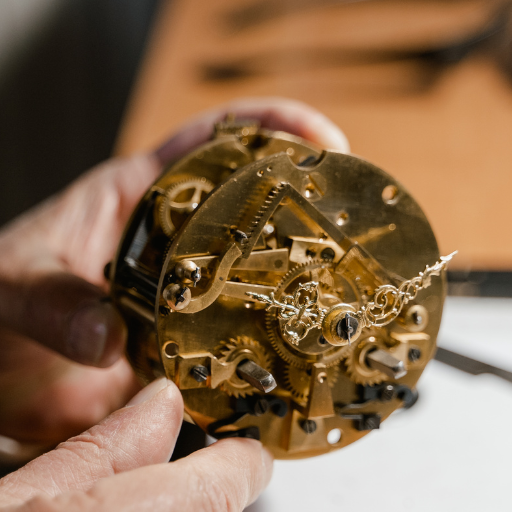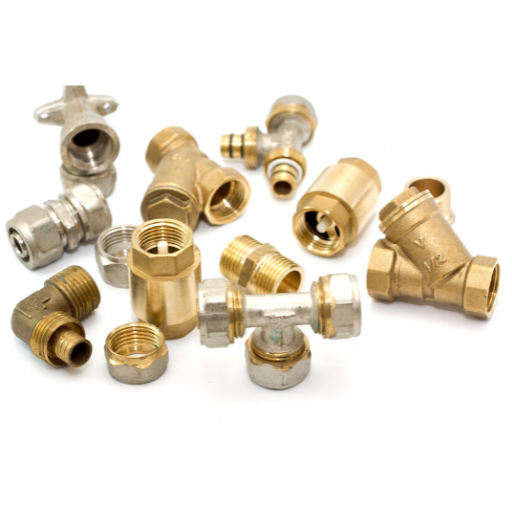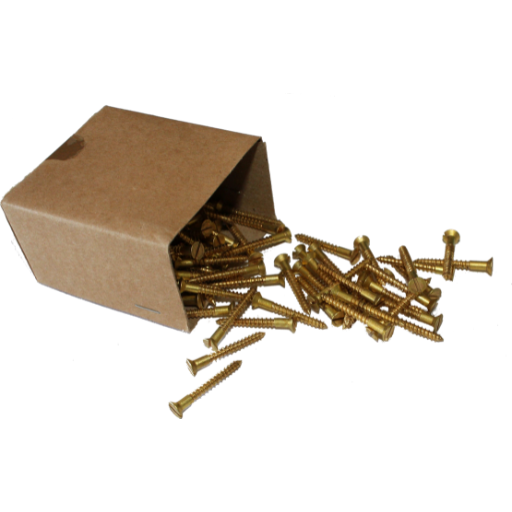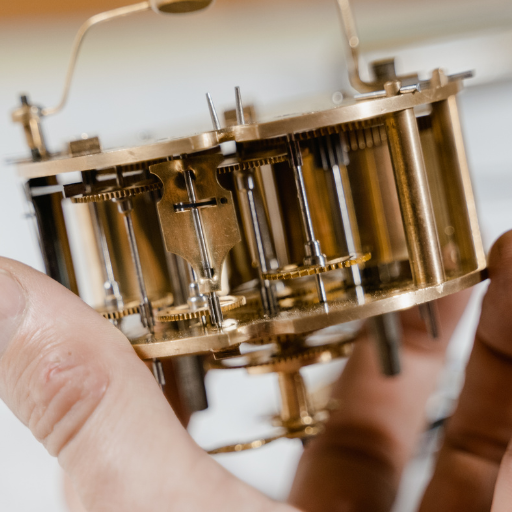What are Brass Components?

How is brass made?
The process of manufacturing brass includes the melting and blending of copper and zinc in definite amounts.Most commonly, alloying is used to produce brass — this involves combining copper with zinc inside a furnace. Initially, copper is liquefied; as soon as it becomes liquid, zinc is poured into it. The quantities of these two metals may vary according to required properties but usually around 60-70% Cu and 30-40% Zn are found in brasses. Occasionally other metals such as lead or aluminium are incorporated into the mix for specific benefits in certain applications of the material. The melted mixture is shaped by pouring it into moulds which solidify as ingots or other forms; these can then be cast, rolled or extruded further to give finished products suitable for various uses once they have cooled down and hardened again.
What makes brass different from bronze?
Both brass and bronze are copper alloys, but their composition and properties diverge significantly. Brass is composed of mainly copper and zinc while bronze consists of copper combined with tin, often along with small amounts of other elements like aluminium, manganese or nickel. This distinction in composition leads to differentiating features between the two alloys.
Brass is recognized for its bright golden appearance, malleability, and acoustic resonance; thus it is commonly used in decorative applications as well as musical instruments. It also has good ductility which means that it can be stretched without breaking easily when subjected to tensile stress.
On the contrary, bronze is generally more wear resistant and harder than brass making it suitable for applications where these qualities are required such as bushings bearings gears etc. Also, the friction coefficient of bronze is lower than that of brass hence improving its suitability for use in mechanical systems. Furthermore, visually bronze has a unique reddish-brown coloration which sets it apart from brasses.
To sum up though both alloys have copper bases in them; zinc found in brasses together with tin found in bronzes brings about dissimilarities physical and mechanical properties thus making each suitable for different purposes.
Why is brass considered a metal alloy?
What are the Properties of Brass?

Brass is a useful material for many applications because it has some important properties. Here are several of them:
- Excellent Malleability: Brass can be easily worked with which allows more complex parts to be made easily.
- Good Conductivity: This metal demonstrates good thermal and electrical conductivity, thus it is used in such items as electric connectors or radiators.
- Corrosion Resistance: The addition of zinc improves this property so brass does not corrode in moist surroundings.
- Aesthetic Appeal: Having a beautiful golden color, brass is frequently used for decorative purposes.
- Strength and Durability: Being strong enough but at the same time quite resistant to wear out; therefore various products may be produced from it – starting from musical instruments up to plumbing equipment.
What is the corrosion resistance of brass?
How does copper and zinc affect the properties of brass?
What is the conductivity of brass?
What are the Different Types of Brass?

Brasses made of copper alloys are classified by composition and properties:
- Alpha Brasses: They contain less than 37% zinc and are known for their malleability and corrosion resistance, which makes them suitable for use in cold working processes
- Alpha-Beta Brasses (Duplex Brasses): They contain 37-45% zinc, combining the qualities of both alpha and beta phases. They have more strength than alpha brasses and can be used with hot working processes.
- Beta Brasses: These contain more than 45% zinc giving high-strength but low ductility; typically employed in applications where mechanical strength is required under heavy loads.
- Admiralty Brass: It contains around 30% zinc plus small quantities of tin thereby providing excellent resistance against corrosion particularly in sea water hence its wide usage marine & condenser tubes.
- Lead-Free Brass: Made without Lead so as to promote environmental safety as well as health requirements thus best suited for plumbing works that meet health standards.
- High Brass: Contains about 65% copper and 35% zinc; this type has higher ductility which is why it’s commonly used in musical instruments such as trumpets among others also fine decorative parts too.
What are the grades of brass?
Grades of brass are usually assigned according to what they are made of and their specific uses:
- C220 Commercial Bronze (90-10 Brass): It is made up of 90% copper and 10% zinc, which provides good strength as well as outstanding resistance to corrosion. This type is frequently used in architecture and for hardware.
- C260 Cartridge Brass (70-30 Brass): It contains 70% copper and 30% zinc; this alloy has excellent ductility and is commonly employed for making ammunition casings, automotive parts, electrical components etc.
- C360 Free-Cutting Brass: With approximately 60% copper, 36% zinc, and about 4% lead content by weight; it is known for its ease of machining. Gears, fittings or fasteners often get produced from this material.
- C464 Naval Brass: The composition comprises 60% copper, 39% zinc with some tin added (around 1%). Naval brass offers higher resistance against corrosion in sea water than other types so it can be used for marine hardware such as propellers.
- C485 Architectural Bronze: Manganese bronze also known as architectural bronze contains around 57%-59%Copper,40 %Zinc,Tin & Lead provide high strength along with excellent bearing properties typically utilized in architectural frameworks where heavy loads occur like bridge bearings etc.. Additionally,this material exhibits good resistance against atmospheric conditions which makes it suitable for outdoor applications too.
What are naval brass and its uses?
What are popular brass fittings?
Because they are tough and resistant to corrosion, popular brass fittings include many plumbing, heating, and industrial components. Among the most common brass fittings are:
- Elbows: These redirect the flow of a pipe system at an angle of either 45 or 90 degrees.
- Tees: It has one inlet and two outlets at right angles that create branch lines.
- Couplings: They unite two pipes together so that no leaks occur.
- Adapters: They enable connecting different kinds of pipes like threaded to slip connections.
- Bushings: This fitting is used when you need to reduce a bigger size fitting into a smaller size pipe.
- Unions: For easy disconnection during repair work or replacement of pipes.
- Compression fittings: Used mainly for making secure leak-free joints without having to solder in plumbing work
How is Brass Used in Machines and Components?

Why is brass chosen for machined parts?
What is the role of brass in fasteners?
How is brass used in musical instruments?
Why is Brass an Alloy Ideal Material for Various Applications?

What makes brass a malleable and machinable metal?
How does brass’s resistance to corrosion benefit its applications?
Why is brass ideal for use in electric conductivity applications?
What are the Standards and Grades of Brass?

How do ISO standards classify brass?
What are the varying properties of different grades of brass?
Different types of brass have different properties which make them useful in various applications.
- C36000 (Free-Cutting Brass): Free-cutting Brass, or C36000, is known for its machinability; a higher lead content makes it easier to cut and shape. This grade is used widely in precision engineering, screw machines and gears, valves among others.
- C28000 (Muntz Metal): Composed of about 60% copper and 40% zinc by weight, Muntz metal has good strength with resistance to corrosion. It is commonly employed in marine environments as well as architectural applications such as cladding material for buildings near the sea; also commonly used to manufacture condensers and heat exchangers.
- C26000 (Cartridge Brass): Cartridge brass consists of approximately 70% copper plus 30% zinc offering both strength levels along with ductility being highly formable thus suitable for deep drawing or bending operations where necessary.C26000 may be found in electrical connectors among other uses like radiator cores because it can easily be worked into desired shapes without cracking up too easily even when cold worked heavily during production processes such as stamping out ammo casings where many units are required at once.
What are common brass alloys and their uses?
Different industries use different brass alloys because they have varying amounts of copper and zinc, which determine their applications:
- C36000 (Free-Cutting Brass): This type of brass is famous for being easily machinable thanks to its relatively high lead content. It works well in precision machining operations like turning, milling, or drilling where close tolerances are needed. Gears, valves, fittings or parts for screw machines can be made from this material.
- C23000 (Red Brass): Also known as 85-5-5-5 brass; it contains approximately 85% copper, 5% zinc, 5% lead and 5% tin by weight. Red brass has good corrosion resistance properties so it is often used in plumbing fittings such as pipe nipples and couplings. It also finds applications in electrical equipment where contact with moisture might occur such as terminals for connectors or busbars used outdoors; marine hardware including propeller shafts sleeves etc., pump bodies casings etc.; heat exchanger tube sheets shells etc., valve bodies bonnets seals seats stem nuts washers etc.
- C26000 (Cartridge Brass): This alloy contains about 70% copper and 30% zinc. Cartridge brass has good strength combined with moderate ductility thus making it highly workable i.e., suitable for deep drawing bending folding punching shearing spinning swaging coining upsetting extruding or otherwise cold forming into various shapes without cracking splitting tearing fraying wrinkling or otherwise damaging the metal itself provided that appropriate lubrication cooling support tooling equipment methods parameters techniques conditions are employed during fabrication processes involved therein. Common uses include ammunition casings automotive radiators electrical connectors electronic component leads terminals springs battery contacts.
- C28000 (Muntz Metal): Muntz Metal consists of about 60% Cu – 40% Zn balance may contain small amounts (<1%) Sn Pb P Fe Ni Al impurities Manganese may be present as an intentional alloying addition. It has high strength good corrosion resistance in marine environments where it is used extensively for propeller shafts sleeves etc., pump bodies casings etc.; heat exchanger tube sheets shells etc.; valve bodies bonnets seals seats stem nuts washers etc.. Architectural applications include structural components exposed to salt spray or industrial atmospheres such as handrails balconies decks fences gates grilles louvers panels railings trellises.
- C38500 (Architectural Bronze): Also known as architectural or engraving brass; contains approximately 57-59% Cu balance Zn Pb Sn Fe impurities may be present in trace amounts (<0.1%). Architectural bronze is highly machinable and has good corrosion resistance which makes it suitable for decorative purposes like nameplates plaques signs trimwork hardware lighting fixtures furniture fittings cabinet knobs pulls handles hinges locks latches escutcheons brackets hooks knockers numbers letters keyholes etc.
Reference sources
-
Misumi – What is Brass?
- Misumi’s guide offers an in-depth look into brass, describing its composition, properties, and various applications. This resource provides a comprehensive understanding of why brass is considered a versatile metal alloy.
- Source: Misumi
-
Plumberstar – An Ultimate Guide on Brass as a Manufacturing Material
- Plumberstar’s article delves into the nature, properties, and uses of brass. It covers the alloy’s unique characteristics and its suitability for different manufacturing contexts, making it an essential read for those looking to understand brass components.
- Source: Plumberstar
-
Copper Development Association – #ChooseBrass: The Timeless Metal Shaping Modern Progress
- This guide from the Copper Development Association highlights the diverse range of brass alloys and their applications. It discusses the material’s properties, including its composition and benefits, providing valuable insights for both engineering and decorative uses.
- Source: Copper Development Association
Frequently Asked Questions (FAQs)
Q: What is brass?
A: Brass is a metal alloy composed primarily of copper and zinc. The proportions of zinc and copper can vary, creating a range of brasses with different properties.
Q: How does brass differ from bronze?
A: While both brass and bronze are copper-based alloys, bronze is typically an alloy of copper and tin, while brass is an alloy of copper and zinc. This difference in composition gives them distinct properties and uses.
Q: What are some common uses of brass?
A: Brass is often used in applications requiring high corrosion resistance, such as plumbing fittings, musical instruments, and decorative items. Its excellent formability and attractive appearance make it ideal for doorknobs, lock mechanisms, and more.
Q: Why is brass considered a versatile metal?
A: Brass is considered versatile due to its different compositions, allowing it to be tailored for various applications. It is also resistant to corrosion, has good tensile strength, and can be easily machined to tight tolerances, making it suitable for a wide range of industries.
Q: Can brass be used in CNC machining?
A: Yes, brass is commonly used in CNC machining because of its excellent machinability. Free cutting brass, in particular, allows for precise, tight tolerances and is often used in engineering and manufacturing.
Q: What are the advantages of using brass over other metals?
A: Brass offers several advantages over other metals, including high corrosion resistance, good tensile strength, and excellent formability. Additionally, brass due to its non-ferrous nature, does not spark, making it ideal for use in explosive environments.
Q: How is brass produced?
A: Brass production typically involves melting copper and zinc together. The melting point and proportions of the components are carefully controlled to produce brass with desired properties. Different metals like silicon, arsenic, and phosphorus can sometimes be added to achieve specific traits.
Q: What is the significance of high corrosion resistance in brass?
A: The high corrosion resistance of brass makes it suitable for use in harsh environments where other metals might degrade. This property is particularly important for plumbing, marine applications, and outdoor fixtures.
Q: What does the term “red metals” refer to, and how is brass related?
A: The term “red metals” refers to copper and its alloys, such as bronze and brass. These metals are distinguished by their reddish color and share similar advantageous properties like corrosion resistance and formability.
Q: Can brass have health benefits?
A: Yes, brass kills bacteria on contact, making it beneficial for applications like doorknobs and hospital fixtures where reducing the spread of germs is crucial.








